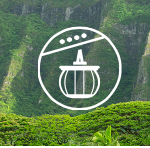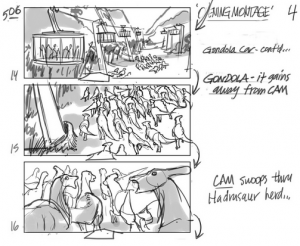 The Gondola Lift was an attraction in the Jurassic World theme park. It utilized gondola cars to bring tourists to the height of the Western Ridge, one of three main mountain ranges on Isla Nublar, from which point visitors could view much of the island and its de-extinct inhabitants. It was the means of access to Lookout Point, the island’s most scenic site.
The Gondola Lift was an attraction in the Jurassic World theme park. It utilized gondola cars to bring tourists to the height of the Western Ridge, one of three main mountain ranges on Isla Nublar, from which point visitors could view much of the island and its de-extinct inhabitants. It was the means of access to Lookout Point, the island’s most scenic site.
Name
The gondola is a type of aerial lift used for cable transport where elevation may not permit other forms of travel, sharing its name with the boat often used for navigating artificial canals. The name “gondola lift” is generally applied to all transports of this type, and the instance used in Jurassic World does not have a unique name.
Location
Jurassic World’s Gondola Lift was located within the Western Ridge, the mountain range near the island’s west coastline. There was at least one cable line running east-west into the mountains and reaching the range’s highest point. The base of the lift was located near a small river within the mountain range, in Sector 2 just west of the Bamboo Forest; some concept art suggests that the cable system extended north into Sector 4, but this is unconfirmed. The base of the lift was associated with a monorail station.
Description

The base of the Gondola Lift was connected to Jurassic World’s monorail system, allowing guests to easily access the attraction via a short path through the woods after departing the monorail. Guests would board the sky gondola cars here; the cars were round and mostly made up of a transparent outer shell to allow panoramic views of the mountain. Each car had a capacity of at least two people (concept art implies larger cars with at least an eight-person capacity). Sliding doors were automatic, opening when each car reached a lift station and closing once the car was boarded. The lift system’s motion was also automated and able to detect when visitors were boarding, pausing its movement until all passengers were on board. The system was solar-powered, but could probably draw power from the island’s electrical grid in the event of a cloudy day. Riding to the top would take five to ten minutes depending on how often the ride stopped to let passengers on or off.
The lift system itself consisted of a loop of steel cable strung between support towers as well as the base and summit stations. Support towers were a few hundred feet apart. The whole system was have been driven by two bullwheels, one at the base terminal and one at the summit terminal; an engine or motor was used to power it. At base, the waiting area had a few seats located on a fenced, raised concrete terrace where visitors could rest. The waiting area was decorated with park flags and all-weather umbrellas hued in Jurassic World blue. Over the sky gondola control terminal there was a tinted glass roof which would provide some relief from the sun without fully blocking out natural light. To access the seating area, there were both stairs and ramps. At the top was a similar station, opening out to Lookout Point.

Based on concept art, there is a possibility that other cable lines may have existed. The concept art in question depicts a north-south line which appears to extend into Sector 4, with an outgoing and returning line to increase the capacity and rate at which visitors could board and depart. This line is depicted traveling through a valley along a horizontal path rather than ascending the mountains.
History
Construction
It is not currently known when the Gondola Lift was constructed, but there is no evidence that it was being constructed as of September 2004. It was most likely built sometime after this.
2005-2015: Operational years
The Gondola Lift operated between 2005 and 2015, bringing hundreds of thousands of guests up the Western Ridge. While it was not the most highly-advertised of park attractions, the Gondola Lift was still popular enough to frequently appear in park pamphlets and warrant mention in the Romance Package. It was most popular among couples, particularly those seeking slower, more relaxing views of Jurassic World. According to the park website, marriage proposals were sometimes seen at the summit. Less dramatically, couples would often picnic at the summit.
2015-2016: Repurposed following closure
On December 22, 2015, Jurassic World closed its gates permanently due to an incident involving an escaped genetically modified animal. The Gondola Lift, like all the other park attractions, was abandoned as the island was evacuated and animals were allowed to roam freely. For the first six months after the park was shut down, animals seem to have paid little attention to the Gondola Lift as it was mostly undisturbed in June, looking more or less as it had been in December. Solar power meant that it could still function on sunny days.
Since animals could not utilize the lift, the only way to the summit was walking; that is, unless one could fly. This meant that the summit became a safe haven for Dimorphodons, which nested at Lookout Point. Other animals, such as Ceratosaurus, lived near the base. This micro-ecosystem was disturbed six months after the park closed by the six members of Camp Cretaceous, who had been left behind during the Jurassic World evacuation and had lived on the island since. They used the Gondola Lift to access Lookout Point in search of fabric to build a raft sail. Unaware of the Dimorphodons breeding on the island, the campers disturbed the nesting site and were forced to flee.
Shortly thereafter, the Lookout Point cable loop was damaged by Ben Pincus and Darius Bowman, who used the Gondola Lift as an improvised explosive delivery system. Their goal was to distract an escaped creature which was causing ecological devastation to Isla Nublar. This plan worked at the cost of Lookout Point and the animals breeding there. The base station also suffered damage from flaming debris flung from the summit, and probably from the resultant fires.
2016-present: Final abandonment
Between 2015 and 2018, animals could have accessed the now-shut-down gondola system, but not much is known about the Western Ridge’s animal inhabitants. Allosaurus are known to have lived in that part of the island as of 2018, and concept art suggests that hadrosaurs were found in parts of the Western Ridge that included their habitat range.
While much of the island’s attractions suffered damage due to severe storms within mere months of the park’s closure, the Gondola Lift was spared, most likely due to its sheltered location within the Western Ridge. A systems check performed in February 2018 by the Dinosaur Protection Group suggested that the Gondola Lift was still serviceable, suggesting that there were indeed cable lines other than just the one leading to Lookout Point.
On June 23, 2018, the stratovolcano Mount Sibo violently erupted and caused severe damage to most of the island. As the Western Ridge is well within the range which was affected by lava bombs, extreme temperatures, and other volcanic effects, it is likely that the Gondola Lift has been damaged and may no longer be serviceable at all.
Cultural Significance
While the Gondola Lift was not the most prominent attraction at Jurassic World, it was still featured in the Romance Package which tourists could purchase when buying tickets. The lift was popular with couples, as it allowed a more slow-paced exploration of Isla Nublar and spectacular views from the highest point of the Western Ridge. Tourists who had purchased the Romance Package would be treated to an open-air picnic at the summit.
From the summit station, visitors would be able to see most of Isla Nublar; to the north were the Gyrosphere area, Triceratops Territory, and Gallimimus Valley. To the east, visitors could see the Bamboo Forest, and farther east, the Jurassic World Lagoon and Main Street. The view was considered among Isla Nublar’s most romantic, and marriage proposals were sometimes seen at the summit. This was mentioned on the Jurassic World official website, suggesting that the company intentionally promoted this for publicity reasons.
Following the closure of Jurassic World, the Gondola Lift was used a final two times in June 2016 by a group of teenagers who had been left behind during the evacuation. In June, they accessed Lookout Point via the sky gondolas, which were still functional since it ran on solar power. They had intended to use hang gliders left at Lookout Point for fabric to build a raft sail, but were forced to flee when they disturbed the Dimorphodon nests at the summit peak. Shortly after, two of the campers (Ben Pincus and Darius Bowman) used the Gondola Lift to transport a makeshift bomb to the summit station, creating a massive explosion to distract the escaped Scorpios rex from their friends.
Ecological Significance
In order to construct the Gondola Lift, significant tracts of forest in the Western Ridge would have had to have been torn down, and the creation of pathways for the lift system may have necessitated altering the mountains’ geography. Installation of the support towers would have required some degree of excavation, and in order to ensure the safety of the gondola cars, trees and other foliage would have been kept back from the cables. Construction of Lookout Point in particular leveled a section of the mountain peak. All together, building the Gondola Lift likely had a deleterious effect on the Western Ridge’s natural environment.
Eventually, however, the mountain range would have settled into a new equilibrium with the lift built into it. Tourists marveled at Isla Nublar’s beauty, even if it had been irreversibly altered by the park’s existence. In this way, the Gondola Lift helped to encourage preservation of the island’s remaining natural features. De-extinct animals were also introduced in the northern part of the lift; concept art shows herds of Parasaurolophus and Edmontosaurus inhabiting the valleys that had been clear-cut to make way for the towers and cable system. In the years following the lift’s abandonment, predators including Allosaurus and Ceratosaurus began to live in the Western Ridge, likely taking advantage of the grassy valleys and the ample prey they supported. The area provided shelter from the fierce tropical storms and hurricanes that affect the Gulf of Fernandez, making it an ideal place for animals to live. Between December 2015 and June 2016, the summit station was used by the island’s Dimorphodons as a breeding ground. Unfortunately in June the summit station was obliterated in a massive gasoline explosion, most likely killing all the pterosaurs’ eggs as well as any adults guarding them that night. This would have impacted the area’s food web. The base station suffered only minor impact and fire damage, and thanks to the relative isolation of the summit, destruction was otherwise limited.
The summer of 2018 ended the Gondola Lift’s role as a haven for these animals, as the eruption of Mount Sibo most likely caused serious damage to the area. It is uncertain how much of the lift remains, or how much more of the forest was destroyed during the eruption. However, the loss of plant life has certainly caused the collapse of the ecosystem that established there. Today, it is unlikely that any large animals call the Gondola Lift home.

